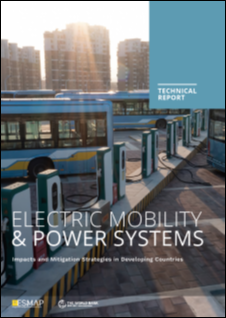 Electric bus fast charging station. ©Koiguo / Moment / Getty Images
Electric bus fast charging station. ©Koiguo / Moment / Getty Images
 With transport today accounting for over 20% of greenhouse gas emissions, the transition to electric mobility (E-Mobility) is promising for decarbonization and a clean transport future. However, the exponential rise of electric vehicles (EVs), which is expected to reach 240 million by 2030, poses technical challenges for power systems, particularly in developing countries. The uptake of EVs in these regions may exacerbate existing issues and further strain already overwhelmed grids.
With transport today accounting for over 20% of greenhouse gas emissions, the transition to electric mobility (E-Mobility) is promising for decarbonization and a clean transport future. However, the exponential rise of electric vehicles (EVs), which is expected to reach 240 million by 2030, poses technical challenges for power systems, particularly in developing countries. The uptake of EVs in these regions may exacerbate existing issues and further strain already overwhelmed grids.
Our new report, "Electric Mobility and Power Systems - Impacts and Mitigation Strategies in Developing Countries," discusses these challenges and provides solutions. Here are some key takeaways:
Technical impacts of E-Mobility on power systems
The impacts range from short-term operational issues to long-term energy system planning effects, as highlighted in the table below. In the initial stages of the transition to electric mobility, the distribution grid segments are at the highest risk. These are susceptible to spatial accumulation of plug-in events even if the national numbers are low, for instance at electric taxi charging stations.
Since the resilience of the distribution network is only as strong as its weakest link, failure of one component can cause severe distortions in the supply to the area. Distribution grids will be the primary source of potential reinforcements needed for EV deployment. As the E-Mobility expands, the power system impacts may extend beyond distribution, affecting generation dispatch or transmission lines. It is therefore critical for countries to assess the current state of their power systems and develop comprehensive plans that consider the technical aspects of both the grid and EVs.
Table : Technical EV Load Power System Impacts in the Context of Developing Countries
| CATEGORY |
IMPACTS |
DEVELOPING COUNTRY CONTEXT |
| Power Demand |
|
|
| Generation System |
|
|
| Transmission System |
|
|
| Distribution System |
|
|
Solutions to mitigate impacts
One solution is smart charging strategies, which can reduce negative impacts while using the potential benefits of vehicle-grid integration (VGI). The primary goal of these strategies is to shift the load to the most optimal time from the system operator's perspective, while also respecting the EV owner's preferences and considering power system constraints.
Another mitigation solution is battery swapping systems, which are gaining popularity in markets with a high percentage of two and three-wheel EVs. For example, in India, the swapping market will have a cumulative average growth rate of 31.3% from 2020 to 2030. Battery swapping stations allow for the quick replacement of discharged batteries with fully charged units, reducing the burden on the power grid during peak demand periods and facilitating renewable energy integration.
In addition, strategic placement of charging infrastructure in areas with ample grid hosting capacity can minimize the need for grid reinforcements. On-site solar generation and battery storage facilities can also increase flexibility and mitigate negative impacts. Standards and interoperability requirements can further improve grid safety and facilitate aggregation.
Finally, reducing EV energy consumption, such as through more efficient cooling systems, can also help to mitigate technical impacts. An ESMAP-funded study in the Middle East and North Africa, has shown that optimizing mobility cooling can save between 7 percent and 30 percent of the electricity consumed by EVs in the region, extending driving range and reducing charging demand.
Implications for electric utilities

However, with challenges comes opportunities. Electric utilities can benefit from the growth of E-Mobility by exploring opportunities in the EV charging market and promoting the adoption of EVs. For example, utilities can partner with municipalities to install public charging stations or offer incentives for EV ownership. By doing so, utilities can increase revenue, attract new customers, and improve customer satisfaction. Planning is critical, and utilities should evaluate the least-cost way to meet the demand while maintaining reliability and security. Utilities can also explore the use of smart grid technologies to help manage the increased demand for electricity from EVs while improving system efficiency and reducing costs.
Planning for the future
Integrated planning of power systems and charging infrastructure is critical for successful EV integration. This is particularly important for developing countries seeking to meet their climate and development objectives, where enabling frameworks must be planned and implemented to ensure their investments and efforts lead to a sustainable E-Mobility transition.
ESMAP conducted a long-term planning study for the Maldives, a small island developing state, that showed that EV adoption would result in a significant increase in generation capacity and the potential increase in power sector emissions in a fossil-fuel-dominated system. Such studies are critical for understanding the implications of EV load impact on power systems and informing broader intersectoral planning.
To delve deeper into the technical impacts and effective mitigation strategies, take a look at our new report available at: https://www.esmap.org/E-Mobility_and_Power_Systems
Subscribe here to stay up to date with the latest Energy blogs.





Join the Conversation